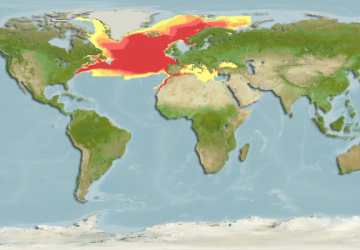Micromesistius Poutassou
– Βlue Whiting –


| Scientific classification |
|---|
Micromesistius poutassou (A. Risso, 1827)
| Kingdom: | Animalia |
| Phylum: | Chordata |
| Class: | Actinopterygii |
| Order: | Gadiformes |
| Family: | Gadidae |
| Genus: | Micromesistius |
| Species: | M. poutassou |


The blue whiting or whiting [1] ( Micromesistius poutassou ) is a marine fish of the family Gadidae , a genus of cods.
The blue whiting, Micromesistius poutassou, one of the two species in the genus Micromesistius in the cod family, is common in the northeast Atlantic Ocean from Morocco to Iceland and Spitsbergen. It also occurs in the northern parts of the Mediterranean, where it may be locally abundant.[1] Blue whiting also occur in the northwest Atlantic Ocean between Canada and Greenland, but is considered rare. It has a long, narrow body and a silvery underbody. The fish can attain a length of more than 40 cm. The average length of blue whiting caught off the west shores of the UK is 31 cm.[2]
A related species, southern blue whiting, Micromesistius australis, occurs in the Southern Hemisphere.
Description
It has an appearance quite similar at first sight to that of the hake but it is easy to distinguish both for the smaller mouth, the large eye and, finally, for the characters of the fins. There are in fact 3 ridges : the first two are small, with a much shorter base than the height; the third longer and lower, symmetrical with respect to the second anal ; the first anal, on the other hand, is very long and reaches the height of the first dorsal fin . The ventral fins are small and placed far forward, the pectoral fins quite developed, the caudal fin is small and forked. The body is elongated and sharp. It is devoid of barbel.
The color is lead gray on the back that fades into the whitish of the belly. The inside of the mouth is black.
It measures 50 cm at the most but usually does not measure more than 25 cm.
Distribution and Habitat
It is a species with a rather northern distribution and is widespread in the eastern Atlantic Ocean between northern Norway , Iceland and Morocco ; it is also present, even if not common, on the North American Atlantic coasts of Canada and northern New England , where it seems to have arrived in the last 50 years. In the Mediterranean Sea it is widespread everywhere except the coasts of the south east; it is common in Italian waters.
It is a pelagic fish , it lives in open waters at depths between 100 and 900 meters on bottoms of at least 500-1000 meters. At night it approaches the surface, no less than 100 meters below the surface, however.
Alimentation
It is carnivorous, hunting planktonic crustaceans and small fish.
Reproduction
Occurs in winter and spring, the eggs are pelagic .
Fishing
It is caught with nets and longlines. The meats are similar to hake but are rather bland and soft. However, they are widely consumed in Lazio and on the coasts of Mount Argentario where, in the town of Porto Ercole , there is also a festival of the “male cunt” as the blue whiting is called in the area.
From Wikipedia, the free encyclopedia
Fisheries
Exploitation of blue whiting only started in the 1970s. The species, in the last decades, has become increasingly important to the fishing industries of northern European countries, including Russia. Catches exceeded 1 million tonnes from 1998 to 2008.[3] According to the Food and Agriculture Organization of the United Nations, blue whiting was fifth most important capture fish species in 2006.[4] However, recruitment of the stock fell to a low level in 2006 and has been weak ever since, causing declining spawning stock and eventually triggering strong reductions in catch quotas. The reasons for low recruitment in recent years are poorly known.[3][5] The total quota for 2011 was set to 40,100 tonnes,[6] which is less than 2% of the record catch of 2.4 million tonnes in 2004. Catches in 2011 exceeded the quota by more than 100%.[7]
For 2012, ICES advised the catches should be no more than 391,000 tonnes (385,000 long tons; 431,000 short tons).[8] This large increase relative to the quota in 2011 (but not to the catches in 1998–2008) is caused by a revision in the stock assessment; however, recruitment to the stock is still low and the stock is forecasted to decline. The coastal states set the total quota for 2012 to 391,000 tonnes.[9]
The fish is usually not marketed fresh, but processed into fish meal and oil. However, in Russia and in southern Europe, blue whiting are sometimes sold as food fish.
Management
Blue whiting in the northeast Atlantic is a straddling stock: it occupies the exclusive economic zone (EEZ) of the Faroe Islands, the European Union, Iceland and Norway, as well as the high seas“.[10] This means effective regulation calls for international co-operation.
Quota advice for blue whiting in the northeast Atlantic is provided by ICES. For a long period, blue whiting fisheries were mainly regulated through nationally set quotas because there was no international agreement about sharing the total quota;[11] consequently, the total catch greatly exceeded the advised quotas[3] However, the Coastal States (the Faroe Islands, the European Union, Iceland and Norway) reached an agreement in December 2005,[12] ending the period of what was sometimes referred to as “Olympic fishing”. Since 2006, the blue whiting fishery has been regulated under this agreement, which gives the greatest share to the European Union, but through quota swaps, Norway has been holding the largest annual quotas.





































































































































































































































































































































































